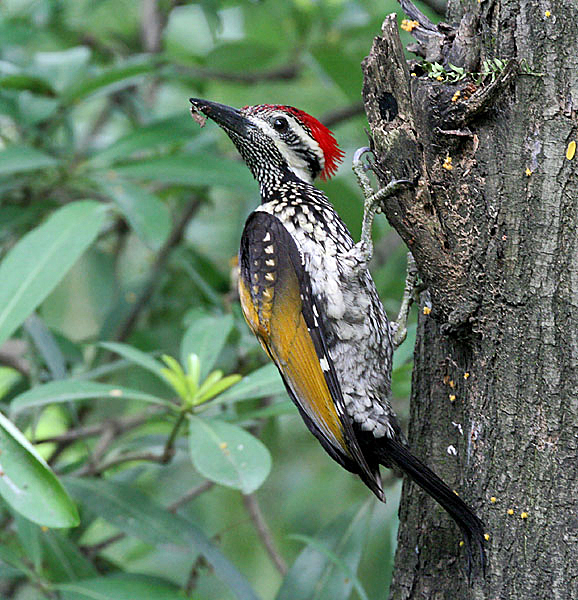|
Poeoptera
''Poeoptera'' is a genus of bird in the Sturnidae, starling family. It contains three species, all live in forest habitats in Africa. These starlings Bird nest, nest in tree cavities, such as old woodpecker or Lybiidae, barbet holes. One species, the narrow-tailed starling, nests in Bird colony, colonies. All are birds of the Canopy (biology), canopy, and their diet is mostly or entirely fruit. Males have a glossier appearance than females. Species * Kenrick's starling (''Poeoptera kenricki'') * Narrow-tailed starling (''Poeoptera lugubris'') * Stuhlmann's starling (''Poeoptera stuhlmanni'') References * Poeoptera, Bird genera Sturnidae Birds of Sub-Saharan Africa Taxa named by Charles Lucien Bonaparte Taxonomy articles created by Polbot {{Sturnidae-stub ... [...More Info...] [...Related Items...] OR: [Wikipedia] [Google] [Baidu] |
Kenrick's Starling
Kenrick's starling (''Poeoptera kenricki'') is a species of starling in the family Sturnidae. It is found in Kenya and Tanzania. Taxonomy Kenrick's starling was described by George Ernest Shelley in 1894 and was named after Major Reginald Watkin Edward-Kenrick, an officer in the British army who collected the holotype in the Usambara Mountains in Tanzania. Shelley placed the starling in the obsolete genus ''Stillbopsar'', which was composed of it alongside Stuhlmann's starling. It is now placed in the genus ''Poeoptera'', meaning "poet bird" in Greek, with Poeo being a variation of the Greek poiéō which means "to create" - being the origin of ''poema'', the Latin word for poem - and ptera coming from the pterá which means wing. Up until the mid 20th century, some authorities considered it conspecific with Stuhlmann's starling, or treated it as one single subspecies. There are currently two recognized subspecies: *''P. k. kenricki'' - ( Shelley, 1894): Nominate subspecies, d ... [...More Info...] [...Related Items...] OR: [Wikipedia] [Google] [Baidu] |
Narrow-tailed Starling
The narrow-tailed starling (''Poeoptera lugubris'') is a species of starling in the family Sturnidae. It is found in West and Central Africa from Sierra Leone to the Democratic Republic of the Congo. Description The male is dark blue and the female is dark gray with chestnut-colored patches on the wings, visible in flight. Both sexes have long, narrow tails. Not a very noisy bird, this starling's vocalizations include shrill chirps, cries, and whistles. Habitat Its habitat is the canopy of lowland forest, making use of secondary forest and forest clearings. Diet It eats mostly fruit, and sometimes insects or seeds. Behaviour These starlings form flocks of 10-30 or more birds, and sometimes will mix with other fruit-eating birds. This bird is a colony-nester, making its nest A nest is a structure built for certain animals to hold Egg (biology), eggs or young. Although nests are most closely associated with birds, members of all classes of vertebrates and some in ... [...More Info...] [...Related Items...] OR: [Wikipedia] [Google] [Baidu] |
Stuhlmann's Starling
Stuhlmann's starling (''Poeoptera stuhlmanni'') is a species of starling in the family Sturnidae. It is native to the Albertine rift montane forests, the East African montane forests The East African montane forests is a montane tropical moist forest ecoregion of eastern Africa. The ecoregion comprises several separate areas above 2000 meters in the mountains of South Sudan, Uganda, Kenya, and Tanzania. Geography The East Af ... and the southwestern Ethiopian montane forests. Their length is usually around 19 cm, and they feed on seed, grain, arthropods and larvae. References Stuhlmann's starling Birds of Central Africa Birds of East Africa Stuhlmann's starling Taxonomy articles created by Polbot {{Sturnidae-stub ... [...More Info...] [...Related Items...] OR: [Wikipedia] [Google] [Baidu] |
Bird Colony
A bird colony is a large congregation of individuals of one or more species of bird that nest or roost in proximity at a particular location. Many kinds of birds are known to congregate in groups of varying size; a congregation of nesting birds is called a breeding colony. Colonial nesting birds include seabirds such as auks and albatrosses; wetland species such as herons; and a few passerines such as weaverbirds, certain blackbirds, and some swallows. A group of birds congregating for rest is called a communal roost. Evidence of colonial nesting has been found in non- neornithine birds (Enantiornithes), in sediments from the Late Cretaceous (Maastrichtian) of Romania. Variations on colonial nesting in birds Approximately 13% of all bird species nest colonially. Nesting colonies are very common among seabirds on cliffs and islands. Nearly 95% of seabirds are colonial, leading to the usage, seabird colony, sometimes called a rookery. Many species of terns nest in colonies ... [...More Info...] [...Related Items...] OR: [Wikipedia] [Google] [Baidu] |
Birds Of Sub-Saharan Africa
Birds are a group of warm-blooded vertebrates constituting the class Aves (), characterised by feathers, toothless beaked jaws, the laying of hard-shelled eggs, a high metabolic rate, a four-chambered heart, and a strong yet lightweight skeleton. Birds live worldwide and range in size from the bee hummingbird to the common ostrich. There are over 11,000 living species and they are split into 44 orders. More than half are passerine or "perching" birds. Birds have wings whose development varies according to species; the only known groups without wings are the extinct moa and elephant birds. Wings, which are modified forelimbs, gave birds the ability to fly, although further evolution has led to the loss of flight in some birds, including ratites, penguins, and diverse endemic island species. The digestive and respiratory systems of birds are also uniquely adapted for flight. Some bird species of aquatic environments, particularly seabirds and some waterbirds, ... [...More Info...] [...Related Items...] OR: [Wikipedia] [Google] [Baidu] |
Bird Genera
Birds are a group of warm-blooded vertebrates constituting the class (biology), class Aves (), characterised by feathers, toothless beaked jaws, the Oviparity, laying of Eggshell, hard-shelled eggs, a high Metabolism, metabolic rate, a four-chambered heart, and a strong yet lightweight Bird skeleton, skeleton. Birds live worldwide and range in size from the bee hummingbird to the common ostrich. There are over 11,000 living species and they are split into 44 Order (biology), orders. More than half are passerine or "perching" birds. Birds have Bird wing, wings whose development varies according to species; the only known groups without wings are the extinct moa and elephant birds. Wings, which are modified forelimbs, gave birds the ability to fly, although further evolution has led to the Flightless bird, loss of flight in some birds, including ratites, penguins, and diverse endemism, endemic island species. The digestive and respiratory systems of birds are also uniquely a ... [...More Info...] [...Related Items...] OR: [Wikipedia] [Google] [Baidu] |
Christopher Helm
Christopher Alexander Roger Helm (born Dundee, 1 February 1937 – 20 January 2007) was a Scottish book publisher, notably of ornithology related titles, including the ''Helm Identification Guides''. Born in Dundee, he was raised in Forfar, where his father was a Presbyterian minister. The family moved to Tunbridge Wells at the start of World War II, and he was educated at Harrow School, then, after active duty in Cyprus with the Highland Light Infantry (as National Service), he graduated in classics and law from Gonville and Caius College, Cambridge in 1960. Having worked for Macmillan, he set up and, in turn, sold each of Croom Helm (founded in 1972, bought by Associated Book Publishers in 1986 and merged into the Routledge imprint in 1992), Christopher Helm Publishers and Pica Press (both of the latter pair being bought by A & C Black, now part of Bloomsbury Publishing Plc). He was an active member of the council of the British Ornithologists' Union, becoming vice-presid ... [...More Info...] [...Related Items...] OR: [Wikipedia] [Google] [Baidu] |
Canopy (biology)
In biology, the canopy is the aboveground portion of a plant community, plant cropping or crop, formed by the collection of individual Crown (botany), plant crowns. In forest ecology, the canopy is the upper layer or habitat zone, formed by mature tree crowns and including other biological organisms (epiphytes, lianas, Arboreal, arboreal animals, etc.). The communities that inhabit the canopy layer are thought to be involved in maintaining forest diversity, Ecological resilience, resilience, and functioning. Shade trees normally have a dense canopy that blocks light from lower growing plants. Early observations of canopies were made from the ground using binoculars or by examining fallen material. Researchers would sometimes erroneously rely on extrapolation by using more reachable samples taken from the understory. In some cases, they would use unconventional methods such as chairs suspended on vines or hot-air dirigibles, among others. Modern technology, including adapted ... [...More Info...] [...Related Items...] OR: [Wikipedia] [Google] [Baidu] |
Lybiidae
Lybiidae is a family (biology), family of birds also known as the African barbets. There are 44 species ranging from the type genus ''Lybius'' of forest interior to the tinkerbirds (''Pogoniulus'') of forest and scrubland. They are found throughout sub-Saharan Africa, with the exception of the far south-west of South Africa. The African terrestrial barbets, Trachyphoninae, range from the southern Sahara to South Africa. Members of one genus, ''Trachyphonus'', are the most open-country species of barbets. The subfamily Lybiinae contains the African arboreal barbets. There are 37 species of Lybiinae in 6 genera. Taxonomy The Phylogenetics, phylogenetic relationship between the African barbets and the eight other families in the Order (biology), order Piciformes is shown in the cladogram below. The number of species in each family is taken from the list maintained by Frank Gill (ornithologist), Frank Gill, Pamela C. Rasmussen and David Donsker on behalf of the International Ornithol ... [...More Info...] [...Related Items...] OR: [Wikipedia] [Google] [Baidu] |
Charles Lucien Bonaparte
Charles Lucien Jules Laurent Bonaparte, 2nd Prince of Canino and Musignano (24 May 1803 – 29 July 1857) was a French naturalist and ornithology, ornithologist, and a nephew of Napoleon. Lucien and his wife had twelve children, including Cardinal Lucien Bonaparte (cardinal), Lucien Bonaparte. Life and career Bonaparte was the son of Lucien Bonaparte and Alexandrine de Bleschamp. Lucien was a younger brother of Napoleon I of France, Napoleon I, making Charles the emperor’s nephew. Born in Paris, he was raised in Italy. On 29 June 1822, he married his cousin, Zénaïde Laetitia Julie Bonaparte, Zénaïde, in Brussels. Soon after the marriage, the couple left for Philadelphia in the United States to live with Zénaïde's father, Joseph Bonaparte (who was also the paternal uncle of Charles). Before leaving Italy, Charles had already discovered a Old World warbler, warbler new to science, the moustached warbler, and on the voyage he collected specimens of a new Wilson's storm-petrel ... [...More Info...] [...Related Items...] OR: [Wikipedia] [Google] [Baidu] |
Woodpecker
Woodpeckers are part of the bird family (biology), family Picidae, which also includes the piculets, wrynecks and sapsuckers. Members of this family are found worldwide, except for Australia, New Guinea, New Zealand, Madagascar and the extreme polar regions. Most species live in forests or woodland habitats, although a few species are known that live in treeless areas, such as rocky hillsides and deserts, and the Gila woodpecker specializes in exploiting cacti. Members of this family are chiefly known for their characteristic behaviour. They mostly forage for insect prey on the trunks and branches of trees, and often communicate by drumming with their beaks, producing a reverberatory sound that can be heard at some distance. Some species vary their diet with fruits, birds' eggs, small animals, tree sap, human scraps, and carrion. They usually nest and roost in holes that they excavate in tree trunks, and their abandoned holes are of importance to other cavity-nesting birds. They ... [...More Info...] [...Related Items...] OR: [Wikipedia] [Google] [Baidu] |





